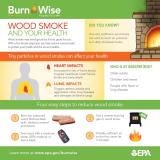Wood Smoke and Your Health
- What is wood smoke?
- Health effects of wood smoke
- Who is at risk from wood smoke?
- Environmental effects
What is wood smoke?
Smoke forms when wood or other organic matter burns. The smoke from wood burning is made up of a complex mixture of gases and fine particles (also called particle pollution, particulate matter, or PM). These microscopic particles can get into your eyes and respiratory system, where they can cause health problems such as burning eyes, runny nose, and illnesses such as bronchitis. In addition to particle pollution, wood smoke contains several toxic harmful air pollutants including: benzene, formaldhyde, acrolein and polycyclic aromatic hydrocarbons (PAHs).
Health effects of wood smoke
Smoke may smell good, but it's not good for you. Both short- and long-term exposures to particle pollution from wood smoke have been linked to a variety of health effects.
Short-term exposures to particles (hours or days) can aggravate lung disease, causing asthma attacks and acute bronchitis, and may also increase susceptibility to respiratory infections. Long-term exposures (months or years) have been associated with problems such as reduced lung function and the development of chronic bronchitis—and even premature death. Some studies also suggest that long-term PM 2.5 exposures may be linked to cancer and to harmful developmental and reproductive effects, such as infant mortality and low birth weight.
Who is at risk from wood smoke?
Wood smoke can affect everyone, but children, teenagers, older adults, people with lung disease, including asthma and COPD or people with heart diseases are the most vulnerable. Research indicates that obesity or diabetes may also increase risk. New or expectant mothers may also want to take precautions to protect the health of their babies, because some studies indicate they may be at increased risk.
It's important to limit your exposure to smoke—especially if you are more susceptible than others:
- If you have heart or lung disease, such as congestive heart failure, angina, chronic obstructive pulmonary disease, emphysema or asthma, you may experience health effects earlier and at lower smoke levels than healthy people.
- Older adults are more likely to be affected by smoke, possibly because they are more likely to have chronic heart or lung diseases than younger people.
- Children also are more susceptible to smoke for several reasons: their respiratory systems are still developing; they breathe more air (and air pollution) per pound of body weight than adults; and they're more likely to be active outdoors.
Learn how to reduce wood smoke and lower your risk.
Environmental effects of wood smoke
The particles in wood smoke can reduce visibility (haze) and create environmental and aesthetic damage in our communities and scenic areas – like national parks.

